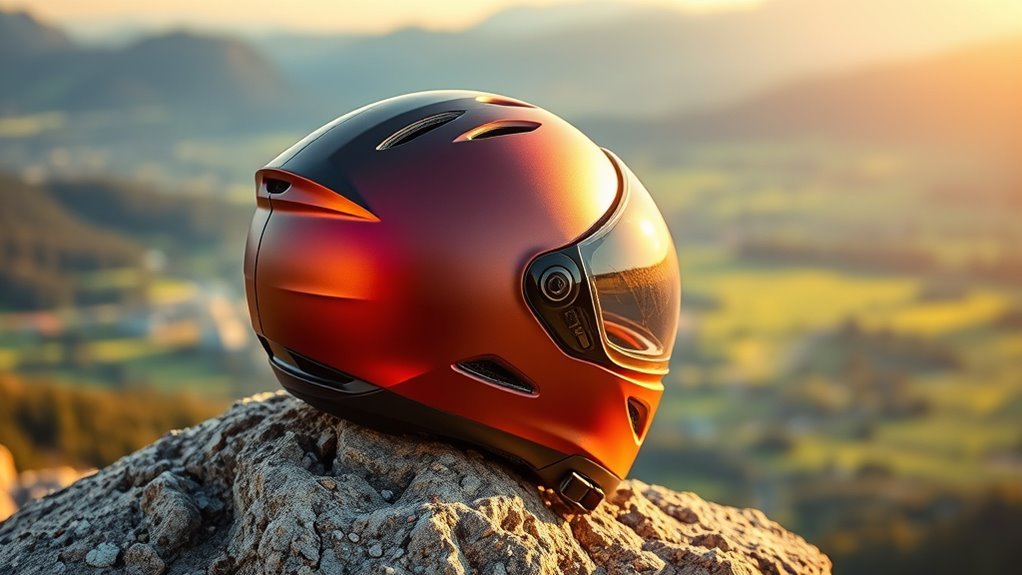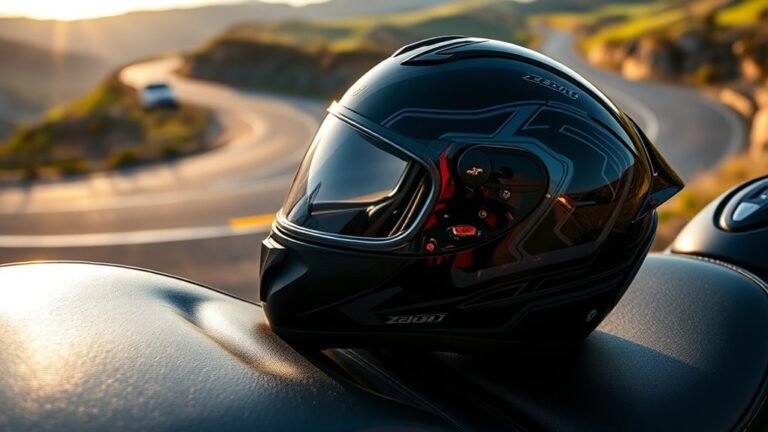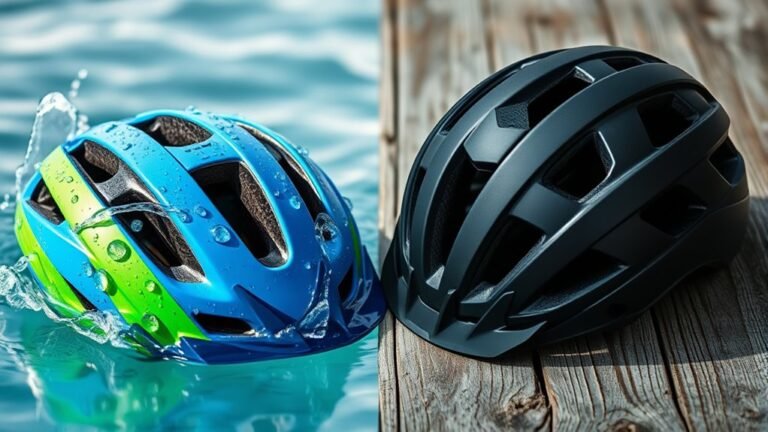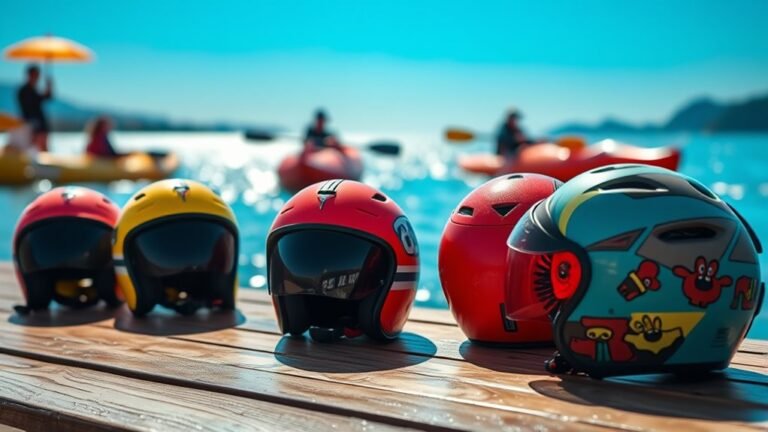Helmets for Paragliding: Safety and Design Features
When paragliding, wearing a helmet is essential to prevent head injuries, as about 30% of incidents involve head trauma. Helmets come in various types, such as full face and open face, each with distinct safety features like impact resistance and visibility enhancements. Materials like carbon fiber and EPS foam provide durability and shock absorption. It’s important to choose a well-fitted helmet that offers comfort and ventilation. Explore various options to determine what best meets your safety and design needs.
Importance of Helmet Safety in Paragliding
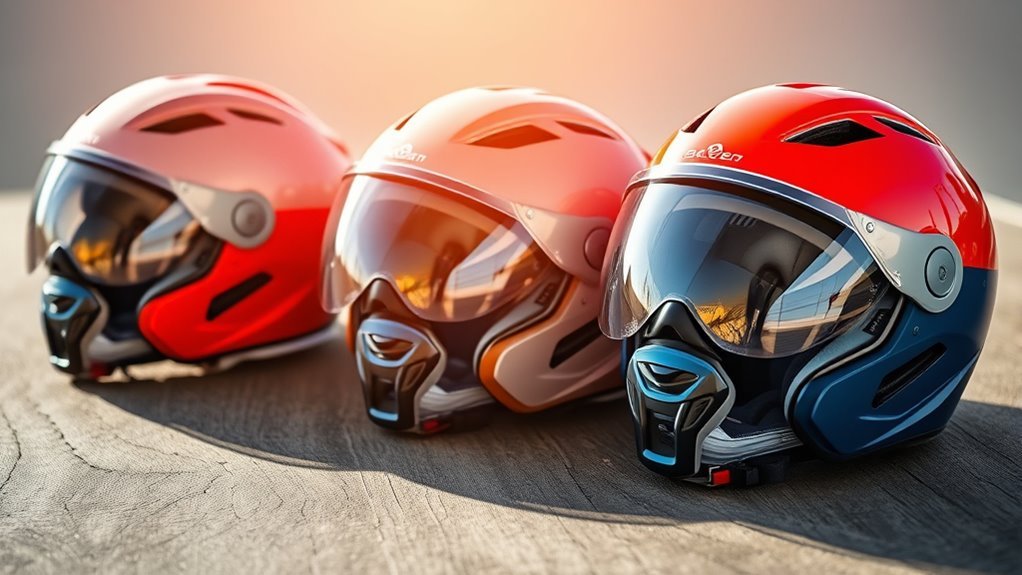
When you take to the skies in a paraglider, ensuring your safety is paramount, and that starts with wearing a helmet. Helmet regulations are established to reduce the risk of head injuries, which constitute a significant percentage of paragliding accidents. According to accident statistics, roughly 30% of paragliding incidents involve head trauma, often resulting from collisions or unexpected landings. A properly fitted helmet can mitigate these risks by absorbing impact forces and providing essential protection. By adhering to established helmet regulations, you not only safeguard yourself but also contribute to a culture of safety within the paragliding community. Embracing this freedom in the skies should come with a commitment to personal safety, ensuring that your adventures remain exhilarating and, most importantly, safe.
Types of Helmets for Paragliding

There are several types of helmets designed specifically for paragliding, each catering to different needs and preferences. Full face helmets provide maximum protection, covering the entire head and face, which is essential for those who prioritize safety during high-speed descents or turbulent conditions. They often feature visors for enhanced visibility against wind and debris. On the other hand, open face helmets offer a balance between protection and freedom, allowing for better communication and a more immersive experience while flying. They protect the top and sides of your head while leaving your face exposed, which can be advantageous in calm conditions. Choosing between these types depends on your flying style and risk tolerance, ensuring you feel secure yet free in the skies.
Key Safety Features of Paragliding Helmets
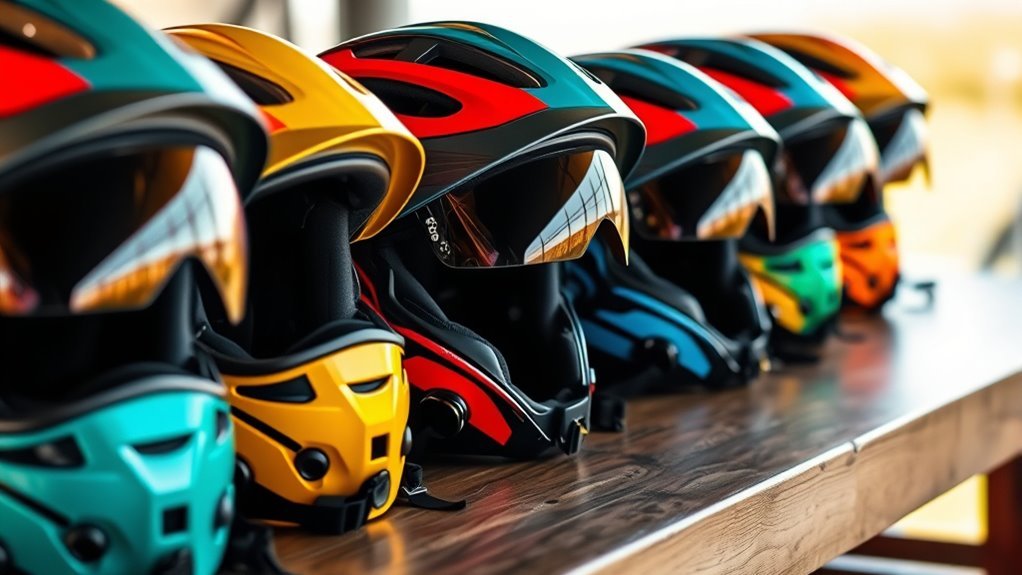
When selecting a paragliding helmet, it’s vital to take into account key safety features that enhance performance and protection. You’ll want to evaluate impact resistance standards to guarantee adequate protection, as well as ventilation for comfort during your flight. Additionally, visibility and audio features can greatly affect your situational awareness, making them essential for safe navigation in the air.
Impact Resistance Standards
Impact resistance standards are essential for ensuring the safety of paragliding helmets. These standards dictate the parameters for impact testing, evaluating how well a helmet can absorb shock during a fall or collision. Compliance with safety regulations, such as those set by organizations like ASTM or CE, guarantees that the helmet meets minimum performance criteria. During impact testing, helmets undergo rigorous evaluations to determine their ability to withstand forces without compromising structural integrity. This analysis is vital for you as a paraglider, as it directly affects your protection in critical situations. By choosing a helmet that adheres to these standards, you’re not just ensuring compliance; you’re investing in your safety and freedom to explore the skies with confidence.
Ventilation and Comfort
Ventilation and comfort are essential considerations in the design of paragliding helmets, directly influencing your performance and safety during flight. Effective airflow technology allows for ideal air circulation, reducing heat buildup and keeping you cool as you soar through the sky. With strategically placed vents, these helmets facilitate airflow without compromising structural integrity. Additionally, advanced moisture management systems wick away sweat, preventing discomfort and distraction during your flight. This combination of airflow and moisture control guarantees that you can maintain focus and enjoy the exhilarating experience of paragliding. By prioritizing ventilation and comfort, manufacturers create helmets that enhance not only your safety but also your overall freedom in the air.
Visibility and Audio Features
How critical are visibility and audio features in ensuring your safety while paragliding? These elements enhance your awareness and communication, essential for a safe flying experience. Key features include:
- Visibility Enhancements: Anti-fog visors and reflective surfaces help you maintain a clear view, even in varying weather conditions.
- Peripheral Vision: Designed to minimize blind spots, these helmets allow you to monitor your surroundings effectively.
- Audio Integration: Built-in communication systems enable real-time conversations with fellow pilots, improving coordination and safety.
- Wind Noise Reduction: Advanced materials dampen external sounds, allowing you to focus on critical audio cues from your environment.
With these features, you can embrace the freedom of flight while prioritizing your safety.
Materials Used in Helmet Construction
Helmets designed for paragliding are engineered using a variety of materials that balance safety, weight, and comfort. The primary materials include carbon fiber and impact foam, both of which play essential roles in enhancing performance. Carbon fiber provides a lightweight yet sturdy shell, allowing for better aerodynamics and less fatigue during long flights. Impact foam is vital for absorbing shocks during potential impacts, ensuring that your head remains protected.
| Material | Function |
|---|---|
| Carbon Fiber | Lightweight shell |
| Impact Foam | Shock absorption |
| EPS Foam | Energy dispersion |
| Polycarbonate | Scratch resistance |
| Kevlar | Enhanced durability |
The Role of Fit and Comfort in Helmet Design
While the materials used in helmet construction are vital for safety, the fit and comfort of a helmet play an equally important role in guaranteeing a pilot’s performance and enjoyment during flights. A proper fit assessment is essential, as it minimizes distractions and enhances focus. Here are key factors to take into account for comfort adjustment:
The fit and comfort of a helmet are crucial for a pilot’s focus and overall flight experience.
- Size: Confirm the helmet matches your head circumference for a snug yet comfortable fit.
- Padding: Look for adjustable padding that conforms to your unique head shape.
- Strap System: A reliable strap system prevents movement during flight, enhancing stability.
- Weight: Lightweight designs reduce fatigue, allowing you to enjoy longer flights without discomfort.
Investing time in these aspects guarantees your helmet not only protects but also promotes freedom in the skies.
Ventilation and Temperature Control
Effective ventilation is essential for maintaining comfort during paragliding, especially as temperatures fluctuate with altitude and speed. Proper airflow dynamics within your helmet can greatly enhance thermal regulation, ensuring you stay cool during high-intensity flights. Look for helmets with strategically placed vents that promote efficient air exchange, allowing heat and moisture to escape while drawing in fresh air. This design minimizes the risk of overheating, which can be detrimental to your performance and enjoyment. Additionally, helmets with adjustable ventilation systems give you the flexibility to control airflow based on changing weather conditions. By prioritizing ventilation features, you’ll not only enhance your comfort but also improve focus and safety during your exhilarating flights through the skies.
Additional Features to Consider
When selecting a paragliding helmet, you should consider additional features that can greatly enhance your flying experience. These aspects not only improve safety but also contribute to comfort and functionality. Here are four key features to evaluate:
- Visor options: Choose between clear, tinted, or removable visors to adapt to varying weather conditions and personal preferences.
- Padding types: Different padding materials can impact comfort during long flights. Look for moisture-wicking and shock-absorbent options.
- Chin strap: Guarantee a secure fit with adjustable chin straps, reducing the chance of helmet displacement.
- Weight: Lightweight helmets can improve overall mobility and reduce fatigue during extended flights.
These features offer both protection and an enhanced sense of freedom while soaring through the skies.
Maintenance and Care for Your Helmet
To guarantee your paragliding helmet remains in prime condition, it’s vital to implement a routine maintenance and care regimen. Regular helmet cleaning is essential; use a mild soap and water solution to wipe down the exterior, avoiding harsh chemicals that can degrade materials. Make sure you dry it thoroughly to prevent mold and mildew. After each flight, inspect for any signs of damage, such as cracks or dents, and replace the helmet if necessary.
In terms of storage practices, keep your helmet in a cool, dry place, away from direct sunlight and extreme temperatures. Using a dedicated bag can protect it from scratches and impacts. By maintaining these habits, you’ll make certain your helmet serves you well, allowing you to embrace the freedom of flight confidently.
Choosing the Right Helmet for Your Needs
How do you determine which paragliding helmet best suits your needs? Start with a fit assessment to guarantee comfort and security. A well-fitted helmet can greatly enhance your flying experience and safety. Consider these key factors:
Start with a fit assessment to ensure comfort and security for an enhanced flying experience and safety.
- Protection Level: Assess the helmet’s impact resistance and certification standards.
- Weight: Lighter helmets reduce fatigue during long flights.
- Ventilation: Adequate airflow keeps you cool during thermal conditions.
- Style Preferences: Choose a design that resonates with your personal aesthetic while also meeting safety requirements.
Frequently Asked Questions
Can I Use a Motorcycle Helmet for Paragliding?
You shouldn’t use a motorcycle helmet for paragliding. While it may meet some safety standards, it’s designed for different impacts and lacks the lightweight features necessary for paragliding. The weight of a motorcycle helmet can hinder your maneuverability and comfort during flight. Paragliding helmets are specifically engineered to provide adequate protection while ensuring you maintain the freedom of movement essential for a safe and enjoyable experience in the air.
How Often Should I Replace My Paragliding Helmet?
“Better safe than sorry.” You should replace your paragliding helmet every 3-5 years, depending on usage and impact factors. Frequent flights or any incidents that could compromise its integrity warrant an immediate replacement. Helmets have a limited lifespan, and materials degrade over time, reducing their protective capabilities. Always inspect for visible damage, and trust your instincts; if you feel it’s time for a new one, don’t hesitate to prioritize your safety and freedom.
Are There Age Restrictions for Helmet Usage in Paragliding?
There aren’t strict age restrictions for helmet usage in paragliding, but helmet safety should always be a priority. It’s essential that users of all ages wear a properly fitted helmet to minimize risks during flight. While young pilots often require adult supervision, they should still adhere to all safety protocols. Always check with local regulations and training guidelines to guarantee you meet any specific age requirements and maximize safety in your adventures.
How Do I Properly Clean My Paragliding Helmet?
To properly clean your paragliding helmet, start by using gentle cleaning techniques suited for its materials. Use a soft cloth with mild soap and water for the exterior, ensuring you avoid harsh chemicals that could damage the finish. For the interior, remove any padding if possible, and wash it separately. Rinse thoroughly to eliminate soap residue, then air dry completely before reassembling. Regular cleaning keeps your helmet in top shape, enhancing your flying experience.
What Is the Warranty Period for Paragliding Helmets?
Most paragliding helmets come with warranty coverage ranging from one to three years, depending on the manufacturer. This warranty typically covers defects in materials and workmanship but doesn’t account for wear and tear from regular use. It’s essential to understand your helmet’s lifespan, which can vary based on usage and conditions. Always check the specific warranty details from your manufacturer to guarantee you’re fully informed about protection and longevity for your investment.
